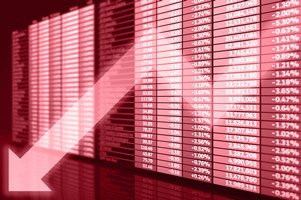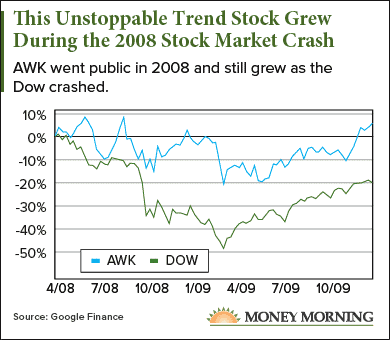If you're looking for a 2018 market crash prediction, it means you're already trying to prepare for the worst-case scenario in the stock market. And that's a smart idea...
 Now, no one can make a stock market crash prediction with any accuracy. At least, not without a lot of luck.
Now, no one can make a stock market crash prediction with any accuracy. At least, not without a lot of luck.
But with stocks soaring to record highs, there are some market crash warning signs to pay attention to. Just yesterday (Oct. 18), the Dow Jones spiked to a record close of 23,157.15. But overnight, Dow futures collapsed as much as 100 points, while the CBOE Market Volatility Index jumped 12% this morning.
Those aren't market-crash numbers, but they show how quickly the stock market can turn, even as it hits new record highs.
And there are two major reasons to be cautious despite soaring highs. Here are our two warning signs, plus what you can do to protect your money right now...
2 Reasons for a 2018 Stock Market Crash Prediction
First, the U.S. Federal Reserve is raising interest rates.
One of the reasons the stock market has been climbing since 2009 is the Fed's lower interest rate policy.
In 2007, the Fed interest rate stood at more than 5%. But by 2008, the Fed had slashed rates all the way to 0.25%, its lowest rate ever.
Urgent: Feds use obscure loophole to threaten retirees. If you have a 401(k), IRA, or any type of retirement account, this could cause you to miss out on $68,870 or more. Learn more...
The idea was to make it cheap and easy for businesses to borrow money. And if they could borrow money cheaply, they could use the money to grow and help raise the economy out of the recession.
The plan worked, in part. Businesses were more than happy to take the cheap loans, but they used the cash to buy stocks
Between 2008 and 2016, publicly traded companies repurchased $2.1 trillion worth of their own stocks, and they borrowed $1.9 trillion while doing it. The stock buybacks helped boost share prices, and it's unlikely they could have done it without the cheap borrowing costs.
Now the Fed is committed to raising interest rates again. Rates rose over 1% this year for the first time since 2008, and they could rise above 2% next year, according to the Fed's "dot plot." That means the era of cheap borrowing is over, and companies won't be able to use the easy loans to repurchase stock. That could weaken stock market growth.
Just-Released: Tips and Tricks to Maximize Your Retirement at Any Age
Second, the stock-buying frenzy has boosted valuations to historic highs.
One of the best measures of stock market valuation is the Cyclically Adjusted Price Earnings (CAPE) ratio, created by economist Robert Shiller. Also known as the Shiller PE ratio, the measure shows how expensive stocks are compared to the company's earnings over a 10-year period.
The Shiller PE ratio is currently at 31.21, 86.2% above its historic average, and even higher than it was before the 2008 stock market crash. The ratio peaked at 27.3 in 2007.
The only other times the Shiller PE ratio has risen higher than it is today was in 1929 and 1999. Both times, the stock market crashed shortly after.
Now, these signs don't mean a stock market crash in 2018 is coming. As we said, no one can predict a stock market crash with accuracy. But they are signs that the record highs that stocks are reaching shouldn't lull you into complacency.
It's always a smart idea to have a plan to protect your money, and we have a simple, proven strategy to do it, right here...
How to Protect Your Money from a 2018 Stock Market Crash
[mmpazkzone name="in-story" network="9794" site="307044" id="137008" type="4"]
Money Morning Chief Investment Strategist Keith Fitz-Gerald recommends Raytheon Co. (NYSE: RTN) and Becton, Dickinson and Co. (NYSE: BDX), because these companies are well-run leaders in the "Unstoppable Trends."
The trick to making huge profits is to find "must-have" companies that fall into what Keith Fitz-Gerald calls the six "Unstoppable Trends": medicine, technology, demographics, scarcity/allocation, energy, and war, terrorism, and ugliness (also known as "defense"). The Unstoppable Trends are backed by trillions of dollars that Washington cannot derail, the Fed cannot meddle with, and Wall Street cannot hijack.
Not only are these stocks resilient during downturns because they are in demand, but they are both sporting double-digit price targets over the next year...
Raytheon Co. (NYSE: RTN) is a leader in the Unstoppable Trend of war, terrorism, and ugliness.
As one of the top five largest defense contractors, Raytheon has billions in contracts with the U.S. government and governments worldwide. International customers make up half of Raytheon's portfolio. And because defense is a global necessity whether the stock market is up or down, Raytheon will always be in demand.
For example, as tensions rise abroad, the United States is more likely to need more weapons and equipment. When the United States launched a missile strike on a Syrian airbase on April 7, Raytheon's stock jumped more than 2%, since its missiles were used.
 RTN currently trades at $186.95 a share and pays a 1.71% dividend yield. RTN is up 31.7% this year, and Wall Street analysts are giving it one-year price targets as high as $212. That could bring owners a 13% gain.
RTN currently trades at $186.95 a share and pays a 1.71% dividend yield. RTN is up 31.7% this year, and Wall Street analysts are giving it one-year price targets as high as $212. That could bring owners a 13% gain.
Becton, Dickinson and Co. (NYSE: BDX) is our best play for the Unstoppable Trend of demographics.
BDX is a healthcare company specializing in single-usage medical products utilized in hospitals and long-term care facilities. But what makes this an Unstoppable Trend is an aging demographic in the United States. As the population gets older, more people will need medical care, especially long-term care. And because people need healthcare no matter what the stock market is doing, BDX's demand will continue to grow.
BDX is also an exceptionally well-managed company, which means it's turning that demand into profits for its investors.
Becton Dickinson has a 10.54% profit margin, even after a $12.2 billion takeover of CareFusion two years ago. That means the company's capital management is sustainable and will easily survive a market downturn. But most importantly, BDX transfers those profits to shareholders through its 1.5% dividend yield and growing share price.
BDX trades at $209.36 and is up 26.46% on the year. Wall Street analysts set one-year price targets for BDX as high as $230, a 10% jump.
Editor's Note: "Must-have" companies backed by Unstoppable Trends are a cornerstone of Keith's wealth-building strategy. But there's another type of investment he wants Money Morning Members to know about. It's one of his favorites, a kind of "desert island fund" he'd buy if he had to park his money in one place, "retire" from civilization for 20 years, and come back to a pile of money. Click here to learn more...
Follow Money Morning on Twitter @moneymorning, Facebook, and LinkedIn.


